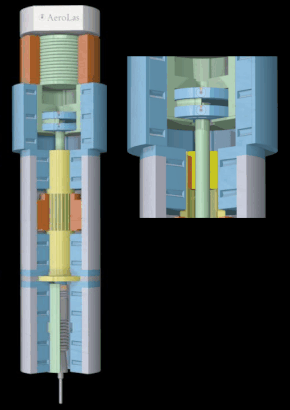
Back Въздушен лагер Bulgarian Luftlager German Cojinete de aire Spanish Zračni ležaj Croatian Zračni ležaj Slovenian 空气轴承 Chinese
This article needs additional citations for verification. (October 2013) |
Air bearings (also known as aerostatic or aerodynamic bearings) are bearings that use a thin film of pressurized gas to provide a low friction load-bearing interface between surfaces. The two surfaces do not touch, thus avoiding the traditional bearing-related problems of friction, wear, particulates, and lubricant handling, and offer distinct advantages in precision positioning, such as lacking backlash and static friction, as well as in high-speed applications.[1] Space craft simulators now most often use air bearings[2] and 3-D printers are now used to make air-bearing-based attitude simulators for CubeSat satellites.[3]
A differentiation is made between aerodynamic bearings, which establish the air cushion through the relative motion between static and moving parts, and aerostatic bearings, in which the pressure is being externally inserted.
Gas bearings are mainly used in precision machinery tools (measuring and processing machines) and high-speed machines (spindle, small-scale turbomachinery, precision gyroscopes).

- ^ Schulz 1999, pp. 6.
- ^ Schwartz, Jana L.; Peck, Mason A.; Hall, Christopher D. (2003-07-01). "Historical Review of Air-Bearing Spacecraft Simulators". Journal of Guidance, Control, and Dynamics. 26 (4): 513–522. Bibcode:2003JGCD...26..513S. doi:10.2514/2.5085.
- ^ Nemanja Jovanovic, et al. Design and Testing of a Low-Cost, Open Source, 3-D Printed Air-Bearing-Based Attitude Simulator for CubeSat Satellites. Journal of Small Satellites Vol. 8, No. 2, pp. 859–880 (2019). https://jossonline.com/letters/design-and-testing-of-a-low-cost-open-source-3-d-printed-air-bearing-based-attitude-simulator-for-cubesat-satellites/